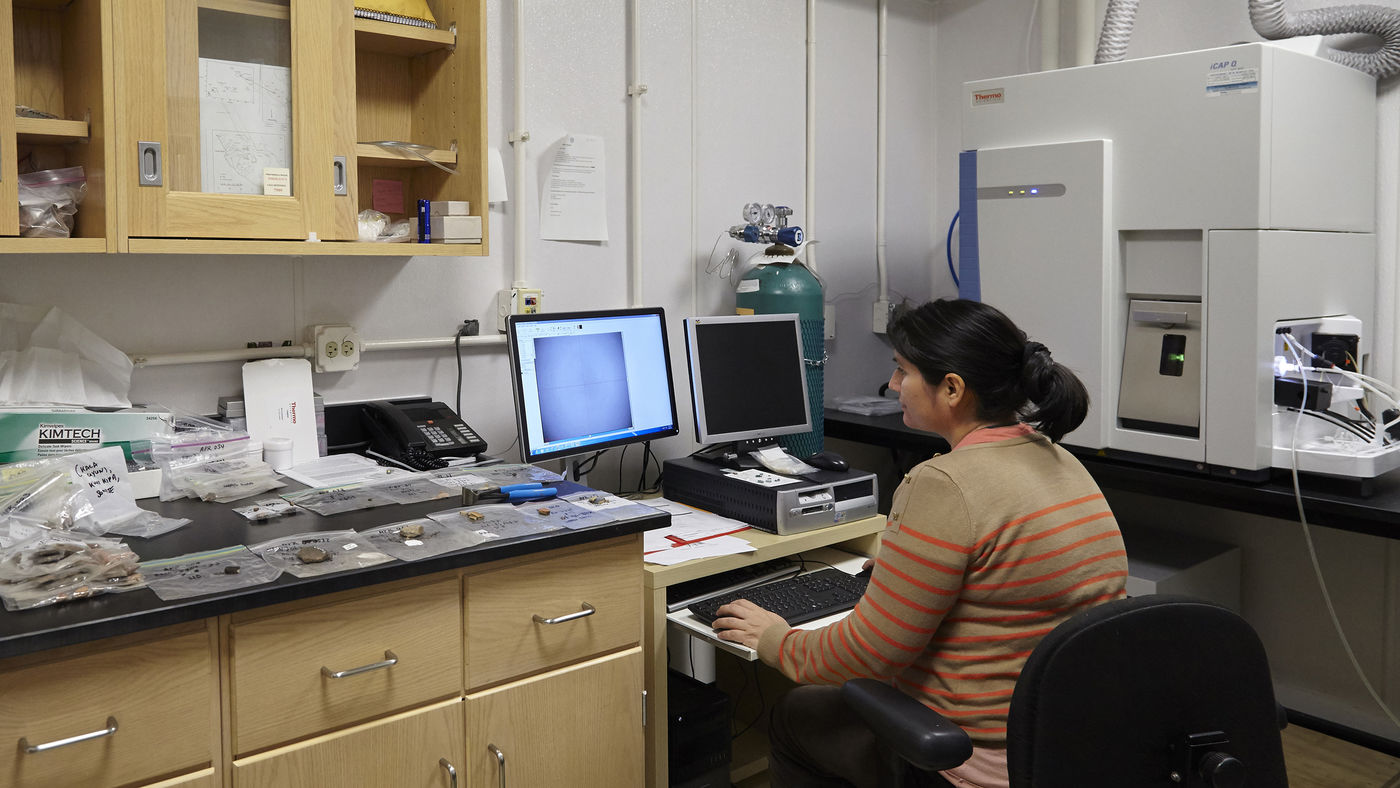Inductively Coupled Plasma-Mass Spectrometry
Inductively Coupled Plasma-Mass Spectrometry (ICP) is a powerful technique of chemical characterization capable of simultaneously measuring up to 50 different elements, including trace elements, sometimes at concentrations as low as several parts per billion. The ICP-MS functions by passing small amounts of material into a plasma, a super-heated gas, which ionizes the sample material. The plasma itself operates at around 8000 degrees C, a temperature greater than the surface of the sun. This ionized sample is then sent through a series of powerful magnets called a mass spectrometer, which separates sample ions on the basis of their mass/charge ratio. These ions are then measured by a detector to establish sample composition.
Samples can be introduced into the ICP-MS either as a vaporized solid, or as a liquid. One such method is Laser Ablation, in which a pulsed laser is used to remove small amounts of sample material, which is then swept into the plasma via a Helium carrier gas. Alternatively, samples can be dissolved in solution and sent into the plasma in liquid form. Depending on sample composition, this may involve dissolving the sample in strong acids, assisted by high heat and pressure produced by bombarding the sample with microwaves. Our Inductively Coupled Plasma Mass Spectrometry (ICP-MS) Laboratory operates around a new Thermo ICAP Q quadrupole ICP-MS and an ESI-Elemental Scientific Lasers NW213 laser ablation system for solid sample introduction. Additionally, the ICP-MS laboratory houses a Milestone microwave digestion system for sample dissolution and liquid sample introduction.

Laser Ablation is particularly valuable due to its ability to target specific components of samples. For ceramics, it is possible to target paste, paints, temper, slips, and glazes separately. In one study performed by museum scientists, the glazes on Chinese Blue and White porcelains and Celadon wares were analyzed chemically by LA-ICP-MS. This study demonstrated that the majority of such ceramics found at archaeological sites in western India and eastern Africa were produced by Chinese kilns, and were not imitation wares produced at Middle Eastern or southeast Asian kilns. Other projects have studied production and exchange of ceramics from Belgian Neolithic sites, proto-historical and historical archaeological sites in the Philippines, Chinese Neolithic sites, ceramics on the northern coast of Papua New Guinea, and archaeological ceramics from throughout the central Andes. Likewise, LA-ICP-MS can be used to analyze metal and corrosion products separately on metal artifacts, eliminating problems that have plagued bulk characterization studies of archaeological metals. LA-ICP-MS is also highly useful for rapidly characterizing obsidian and artificial glasses. The EAF has large ongoing projects applying LA-ICP-MS to characterize glass beads traded in the Indian Ocean, and obsidian from archaeological sites in the western Pacific, Andes, and Belize.
The EAF also houses a portable laser built by the Laboratory of Inorganic Chemistry at ETH Zürich in Switzerland. The unit consists of a laser that operates at 532 nm. The unit is compact and has a mass of less than 10 kg for easy transportation. The light from the laser is coupled to a 2 m long optical fiber with a 450 µm diameter and guided into the laser head that can be hand-held or attached to a tripod. A CCD camera with the same focal plane as the laser is essential to focus the laser at the surface of the sample and also to choose with precision the location to ablate, especially important with corroded areas, multiple colors, inlays etc. Aerosols produced via ablation are deposited onto a Teflon filter using a membrane pump connected to the laser head. This laser is currently being tested for subsequent elemental and isotope (Sr, Pb, Fe and Ag) measurements.